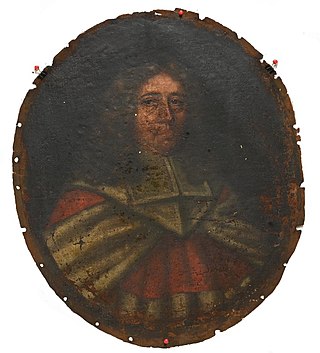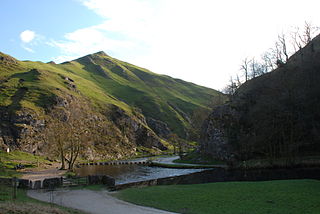
Sir Gilbert Gerard was a prominent lawyer, politician, and landowner of the Tudor period. He was returned six times as a member of the English parliament for four different constituencies. He was Attorney-General for more than twenty years during the reign of Elizabeth I, as well as vice-chancellor of the Duchy of Lancaster, and later served as Master of the Rolls. He acquired large estates, mainly in Lancashire and Staffordshire.
Sir John Alan was a leading English-born statesman in sixteenth century Ireland. He was a member of the Irish House of Commons, and held the offices of Master of the Rolls in Ireland, Chancellor of the Exchequer of Ireland and Lord Chancellor of Ireland. Though he was childless himself, one of his brothers, William, founded a prominent landowning dynasty in County Kildare. The family's holdings included lands at Celbridge, St. Wolstan's and Kilteel, County Kildare, as well as substantial lands in County Dublin. They also acquired a baronetcy.
Sir William Ryves (1570–1647) was a barrister and judge, and a member of a distinguished Dorsetshire family. He enjoyed a successful legal career in Ireland, holding office as Attorney-General for Ireland and as a justice of the Court of King's Bench (Ireland). For a time he acted as Deputy to the Lord Chancellor of Ireland.

Sir Richard Reynell, 1st Baronet, was an English-born judge who had a distinguished career in Ireland and held office as Lord Chief Justice of the King's Bench in Ireland. He was the first of the Reynell baronets of Laleham.

Sir William Gerard (1518–1581) was an Elizabethan statesman, who had a distinguished record of government service in England, Wales and most notably in Ireland. He sat in the House of Commons for Chester for many years, and was Vice-President of the Council of Wales and the Marches.
Sir Richard Osbaldeston was an English barrister who became Attorney General for Ireland. He was the great-grandfather of Richard Osbaldeston, Bishop of London.
Nicholas Nugent was an Anglo-Irish judge, who was hanged for treason by the government that appointed him. He had, before his downfall, enjoyed a highly successful career, holding office as Solicitor General for Ireland, Baron of the Irish Court of Exchequer, and Chief Justice of the Irish Common Pleas, but he was ruined by the rebellion of his nephew William Nugent, which he was accused of supporting.
Sir Lucas Dillon, also called Luke, was a leading Irish barrister and judge of the Elizabethan era who held the offices of Attorney General for Ireland and Chief Baron of the Irish Exchequer. He supported the Lord Deputy Henry Sidney in the cess controversy and the Lord Deputy John Perrot in the Desmond Rebellions. He was held in high regard by Queen Elizabeth, but was accused by his enemies of corruption and maladministration.
Sir James Dowdall was an Irish judge of the Elizabethan era who briefly held office as Lord Chief Justice of Ireland. He should not be confused with James Dowdall, the Catholic martyr, who was his cousin.
Sir John Egerton was an English landowner from the Egerton family and politician who sat in the House of Commons at various times between 1601 and 1614. He became one of the leading politicians in Cheshire and Staffordshire.
The Burnell family were a Dublin family who were prominent in Irish public life and in the arts from the thirteenth to the seventeenth century. They acquired substantial estates in County Dublin, and married into the Anglo-Irish aristocracy. They produced several judges and politicians, a leading playwright, and one of the first female Irish poets. They were staunch Roman Catholics, who opposed the Penal Laws, and supported the Irish Confederacy in the 1640s. They forfeited most of their lands after the failure of the Confederate cause, and never recovered them.
Richard Talbot (c.1520–1577) was a sixteenth-century Irish judge and landowner. He is notable as the ancestor of the prominent Talbot family of Mount Talbot, Dublin, and for his lawsuit against Nicholas Nugent, the future Chief Justice of the Irish Common Pleas.
Sir John Blennerhassett was an English-born judge and politician who became Chief Baron of the Irish Exchequer and sat in the Irish House of Commons as MP for Belfast. He was a member of a prominent Norfolk family which acquired large estates in Ireland, mainly in County Fermanagh. The Blennerhassett family have an enduring connection with County Kerry.
Robert Preston, 1st Baron Gormanston was an Anglo-Irish nobleman, statesman and judge of the fourteenth century. He held several senior judicial offices including, for a brief period, that of Lord Chancellor of Ireland. He was the founder of the leading Anglo-Irish Preston family whose titles included Viscount Gormanston and Viscount Tara.

Thomas Dowdall, also spelt Dowdale, Douedall, or Dowedall, was an Irish barrister and judge who held the office of Master of the Rolls in Ireland.
The chief justice of Connacht was the senior of the judges who assisted the Lord President of Connaught in judicial matters. Despite the chief justice's title, full judicial powers were vested in the Lord President, whose office was established in 1569. Ralph Rokeby was appointed the first chief justice of Connacht, with Robert Dillon as his second justice. Rokeby found his principal duty as chief justice, the introduction of the common law into Connacht, to be a thankless task, writing gloomily to the Government in London that the people of the province "are not willing to embrace justice".
Gerald Comerford (c.1558–1604), was an Irish barrister, judge and statesman of the late sixteenth and early seventeenth centuries. He sat in the House of Commons in the Irish Parliament of 1585–6, and briefly held office as Chief Justice of Munster and as a Baron of the Court of Exchequer (Ireland). He profited from his close family association with the Earl of Ormond. Comerford rose rapidly in the public service to become a trusted servant of the English Crown, and would probably have become one of the dominant political figures in the southeast of Ireland had it not been for his early death.
John Bathe (1536-1586) was an Irish lawyer and statesman of the sixteenth century. He held several important offices, including that of Attorney General for Ireland and Chancellor of the Exchequer of Ireland. He was a member of a prominent landowning family from County Dublin, and himself added to the family estates. His children included the Jesuit William Bathe, who was a noted musicologist.
Sir Lawrence Parsons was an English-born barrister, judge and politician in seventeenth-century Ireland, who enjoyed a highly successful career, despite frequent accusations of corruption and neglect of official duty. His success owed much to the patronage of his uncle Sir Geoffrey Fenton, of his cousin by marriage Richard Boyle, 1st Earl of Cork, and of the prime Royal favourite, the Duke of Buckingham. He was the ancestor of the Earl of Rosse of the second creation. He rebuilt Birr Castle, which is still the Parsons family home.

Lewis Prowde (c.1560-1617) was an English barrister, judge and politician, who sat in the House of Commons as MP for Shrewsbury in the Addled Parliament of 1614.





